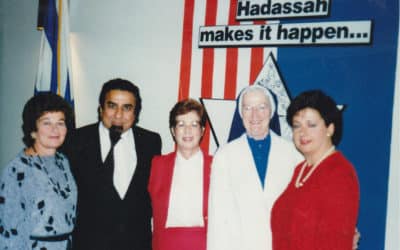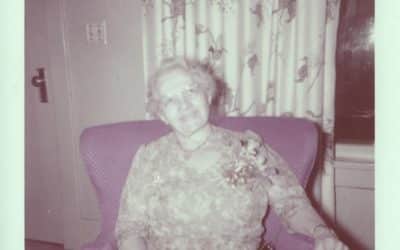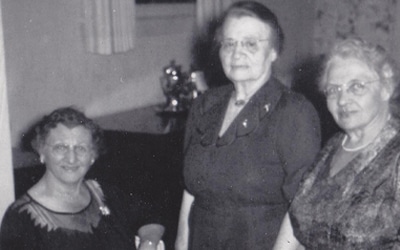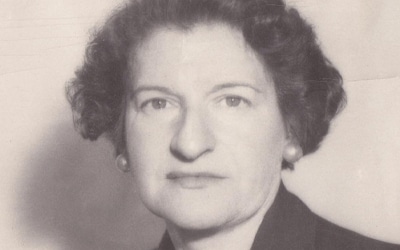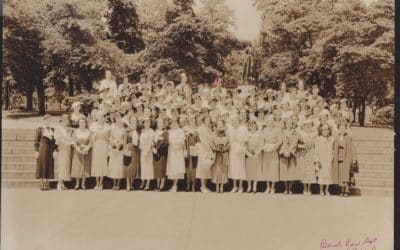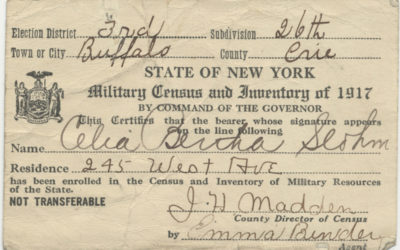Organizations / Hadassah of Greater Buffalo
Overview
National Organization
The idea of an American women’s Zionist fundraising organization crystallized during a trip to Palestine in 1909 by Henrietta Szold, an American Jewish scholar, teacher, and Zionist. Appalled by the poor health conditions in Palestine, Szold sought to form an organization that would meet the health needs of the Jewish settlement in Palestine known as the Yishuv (Hebrew: settlement) and at the same time would kindle enthusiasm for Zionism among American Jewish women. By 1912 she formalized this objective into a discussion group called the Hadassah Chapter of Daughters of Zion. Within a year, two visiting nurses left for Palestine, promoting maternity care and treating trachoma, a contagious eye disease. In Hadassah, Szold brought Jewish women of various ages, backgrounds, and political leanings together at a time when only a minority of American Jews supported Zionism. The organization did so by emphasizing responsive social welfare projects that quickly improved the lives of the recipients. These programs and initiatives blended Jewish religious values and practical Zionism as well as liberal and progressive ideals. Hadassah continues to raise funds for an expanded Hadassah Medical Organization (including Hebrew University of Jerusalem-Hadassah Medical School and the Henrietta Szold Hadassah-Hebrew University School of Nursing and Hadassah College Jerusalem) as well as Young Judaea and the Jewish National Fund. In the United States, Hadassah advocates for women’s and children’s health issues, as well as providing education and advocacy around Zionism. In 2005, Hadassah was nominated for a Nobel Peace Prize for its commitment for promoting peace and coexistence.
Buffalo Hadassah
Buffalo Hadassah was founded on November 27, 1920, at a meeting at Ada Holender Miller’s house in Buffalo. The impetus in part for the meeting was the meeting of the male only, Zionist Organization of America (ZOA) national convention in Buffalo. Although linked to the ZOA as a semi-autonomous companion female organization, national Hadassah guarded its independence from the ZOA, and formerly split with it entirely in 1933. During the 1920s, however, many of Hadassah’s local and national members, were drawn from married couples, whose husbands were ZOA members. At this meeting Ada Miller (formerly Ada G. Holender) was elected first president and Caroline (née Cohn) Kavinoky (husband Dr. Samuel) vice-president. At the meeting which established National Hadassah’s 103rd chapter, twenty-one women became charter members of Buffalo Hadassah. A month later, on December 22, a constitution was ratified.
Campaigns and fundraising began immediately and a year later, Buffalo had the third largest paid-up membership in the United States. One such campaign led to the formation of informal subgroups, and links with non-Hadassah members. For the Palestinian Supplies Bureau collections of linens, an Hadassah subgroup, the Sew and Sews, brought together not just Hadassah members, but Jewish women in other organizations with an interest in sewing and socializing together. In 1924, in part because Hadassah had grown so rapidly, and was active in both various campaigns and fundraising, Henrietta Szold visited the city. She spoke on “The Place of Palestine in Modern Jewish Life,” and Hadassah Buffalo committed to raising $10,000. Just two years later, with the Z.O.A. and the Hadassah national conventions held in Buffalo, membership increased again and was further buoyed by the independent Hadassah convention in 1930. So large was the organization locally, that the membership was split into subgroup along place of residence and existing networks (for example, members of a particular synagogue). Once informal, these several distinctive sub groups blossomed under the broader Buffalo Chapter name as their own groups. Buffalo was the first chapter in the country to separate its membership into groups and its “Buffalo Plan,” became the model for others across the country.
Although these separate groups included younger women, they were distinct from anther Hadassah group. Junior Hadassah was organized in 1921 with Dinah R. Rosenblatt as president and Leya Greenberg as secretary. It grew rapidly, like its older sister group, and by 1938, it was meeting monthly at the Hotel Statler with 125 members. Early on, Celia Slohm (known as Cele) emerged as a leader, rising to President of the Buffalo Junior Hadassah. Within a decade she was serving as President of National Junior Hadassah. Indeed Slohm would serve two terms from 1933 to 1935. During this period, she became an advisor to the Buffalo Chapter and the Upper NY State Region. (On May 7, 1984, at the Region Conference held in Buffalo, on the eve of her 85th birthday, she was honored for her outstanding support, service, counsel and years of dedication to Hadassah). Eventually, Junior Hadassah members transferred their membership as they aged, married and had children, and they moved in one of the Hadassah subgroups.
Other new sub-groups that operated within Hadassah, spoke to changing life styles of women. In 1935, an evening group known as “Business and Professional” or B&P formed for women who worked. Other groups formations tracked changing developments in Jewish Buffalo. The “Suburban” group formed in 1955, as the old “I, II, III” group names disappeared to make way for geographic terms: “North”, “Central “. Later “Intermediates” (post-Junior) and “Evening” emerged (also known as the “Young Marrieds”). From the mid 1950s, historical figures in the Hadassah movement and Israeli names replaced Buffalo place terms, with the creation of groups named Alice Seligsberg, Sabra, Founders, Henrietta Szold and Shalom. In 1957, a group formed with the name IMA (Hebrew: mother) for members who were former refugees, death camp survivors, Displaced Persons (DPs) and new immigrants. IMA members were drawn mainly from Europe, especially Poland and Germany, as well as from Egypt following the Suez Crisis. This group took a special interest in Youth Aliyah and raised money to sponsor children in youth villages in Israel. By 1991 they had sponsored over 50 children. In 1966 Hadassah Associates, a group for men connected to Hadassah, started in Buffalo as part of new national Hadassah program to enable men to participate in fundraising for Hadassah. By the end of the 1960s, “B’not Israel” (Daughters of Israel) emerged as another new group for younger women and the “Founders” group became the Ada Miller group, after the death of the Buffalo Hadassah founder.
Location
Articles
Celia Slohm Bernstein
Celia Slohm Bernstein, Buffalo News, October 17, 1989
Junior Hadassah Elects Celia Slohm President
Junior Hadassah Elects Celia Slohm President, Jewish Telegraphic Agency
Another Voice: U.N. resolution moves the peace process backward
Another Voice: U.N. resolution moves the peace process backward, Buffalo News, January 11, 2017
Buffalo Hadassah celebrates 90 years of service
Buffalo Hadassah celebrates 90 years of service, Amherst Bee, May 04, 2011
Buffalo International Jewish Film Festival to offer diverse mix
Buffalo International Jewish Film Festival to offer diverse mix, Buffalo News, Jul 22, 2020
My View: Israeli hospital offers lesson in diversity
My View: Israeli hospital offers lesson in diversity, Buffalo News, August 3, 2020
Another Voice: Hadassah pushes forward new vision for women’s health
Another Voice: Hadassah pushes forward new vision for women’s health, Buffalo News, May 12, 2019
Gallery
Buffalo Hadassah Myrtle Wreath Awardees, 1985-1986, Gerda Klein on far left, Sister Martin Jones on second from right with nun’s habit, Courtesy of Buffalo Hadassah.
Buffalo Hadassah Myrtle Wreath Awardees, 1985-1986
Ada Miller 1956
Ada Miller 1956
Ada G. Holender (later Miller) c.1900s photograph created by Maud Elkeru. Courtesy of Dr. Joseph Adler.
Ada G. Holender (later Miller) c.1900s
Buffalo Hadassah Leaders, L-R Della Adler, Florence Sukernek, Ada Miller, photographer unknown,1950s. Courtesy of Dr. Joseph Adler.
Buffalo Hadassah Leaders
Celia Slohm (Bernstein), National President of Junior Hadassah,1934. Courtesy of Buffalo Hadassah.
Celia Slohm (Bernstein), National President of Junior Hadassah,1934
Celia Slohm (Bernstein) with hat marked in red, Junior Hadassah Conference Meeting, 1928. Courtesy of Buffalo Hadassah.
Junior Hadassah Conference Meeting, 1928
Celia Bertha Slohm, Identity Card, Military Census and Inventory, 1917. Courtesy of Carol Schmeidler.
Celia Bertha Slohm, Identity Card
Buffalo highlights and the new millennium
Demographic forces once again changed group arrangements. From the mid 1980s, Buffalo Hadassah’s many groups consolidated as Buffalo lost population due to a declining economy. By 2004, a central chapter with the name Hadassah Greater Buffalo Chapter had incorporated all other groups. Since its founding in 1920, Buffalo Hadassah has raised funds to support medical aid in the pre-state Jewish settlement and since 1948, the State of Israel. It has also adopted special programs, most notably Youth Aliyah and Jewish National Fund. As a community-based organization, the Buffalo chapter has also responded to local and regional needs from selling War Bonds, to volunteering at Rosa Coplon, the Veterans Hospital, and more recently, to staffing the Reception Desk on Christmas Day at Sisters Hospital. For many years, Hadassah Buffalo ran a Thrift Shop on Bailey Avenue in Buffalo. The Buffalo Chapter over the years, with its many subgroups, have created educational, cultural and entertainment activities that have enriched the intellectual, social and cultural life of Buffalo. Notable events have included the American debut of the Israel Philharmonic Orchestra, musical shows starring Diahann Caroll and Theodore Bikel as well as special showings of major film releases. Buffalo Hadassah was a major sponsor of the Women’s Plea for Soviet Jewry, and has supported former Soviet Jews in both Israel and the US. As part of a broader commitment to tikkun olam, Buffalo Hadassah has honored local individuals who have made significant contributions to local and national life including Holocaust survivor and human rights activist, Gerda Klein.
The continuing focus of Greater Buffalo Hadassah in the 2020s, now a part of a regional grouping Hadassah Midwest that encompasses Hadassah Chicago-North Shore, Hadassah Great Plains, Hadassah Greater Detroit and Hadassah Upper Midwest regions, remains fundraising for the Hadassah Medical Organization, Jewish cultural programming, education about Israel’s history and Israel current affairs, as well as health education and advocacy. In another adaptation to place and demography, Hadassah Buffalo has a co-presidency (sometimes a tri-presidency) that rotates every three months. For other Hadassah chapters around the country, this may be another Buffalo plan in the making.
Documents
Israel Philharmonic Orchestra Plays at Kleinhans, 1960
Israel Philharmonic Orchestra Plays at Kleinhans, 1960, Sattler’s and Hadassah, sponsored event. Pamphlet, Courtesy of Buffalo Hadassah.
Joel Spiegelman’s New Russian Chamber Orchestra, Hadassah Sponsored. Program Guide, 1978
Joel Spiegelman’s New Russian Chamber Orchestra, Hadassah Sponsored. Program Guide. 1978. Courtesy of Buffalo Hadassah.
Bnot Bee Line Newsletter, 1977
Bnot Bee Line Newsletter, 1977. Courtesy of Buffalo Hadassah.
Buffalo Hadassah and The Zionist District, Trial and Error by Chaim Weizmann
Buffalo Hadassah and The Zionist District, Trial and Error by Chaim Weizmann Book Dramatization, Front Cover of Program, 1950. Courtesy of Buffalo Hadassah.
Israeli Fashions, Fundraising Program, 1959
Northern Buffalo Group, Meeting reminder slip, 1960
Hadassah Headlines, Bulletin, Installation of the Hadassah Groups, 1968
Buffalo Hadassah Gloria Tetewsky, 1986
Ada Miller Newsletter, 1984
Upper NYS Region Conference Program, 1984
Third Annual Ada Miller Fish Fry, Art and Poetry by Gloria Tetewsky, 1983
Hadassah Headlines, Bulletin, Israeli Fashion fundraiser event, 1968
BJE Community Lecture Series, Notice card, 1966
Hadassah Unconventional Musical Review, Program, 1964
Hadassah Ruby Ball Program, 1961
Dedication notice of the opening of Hadassah Hospital in Israel, 1960
Hadassah Group Guide Poem, 1957
Suburban Hadassah Program and Membership Leaflet, 1959
45th Anniversary Invitation and Play
Hadassah Buffalo Follies Program
Hadassah sub-groups numbers and names, 1955
Hadassah Follies Promotional Poem, 1950
Hadassah Follies Flier, 1950
“White Paper, Fight Goes On,” Hadassah Headlines, 1947
Hadassah Sew and Sews, 1946
Hadassah Silver Anniversary Program, Booklet, 1945
Hadassah Headlines, Chapter Bulletin, 1944
Discover More Collections
- Ada Miller, Founder of Buffalo Hadassah honored at the Israel Bonds event in the online resource: NY Heritage Digital Collections
- Ada Holender Miller (1881 – 1968), Genealogy lineage with permission of Larry King
Written Histories
- Selig Adler and Thomas Connolly, From Ararat to Suburbia: The History of the Jewish Community of Buffalo. Philadelphia: The Jewish Publication Society of America, 1960.
- Chana Kotzin, Celebrate 90: The Greater Buffalo Chapter of Hadassah Celebrates 90 Years, Commemorative Booklet, 2011
Contribute to this Page
Thank You
We wish to thank Dr. Joseph Adler for permission to use images of Ada Miller and to Larry King for permission to link to his family genealogy website.


